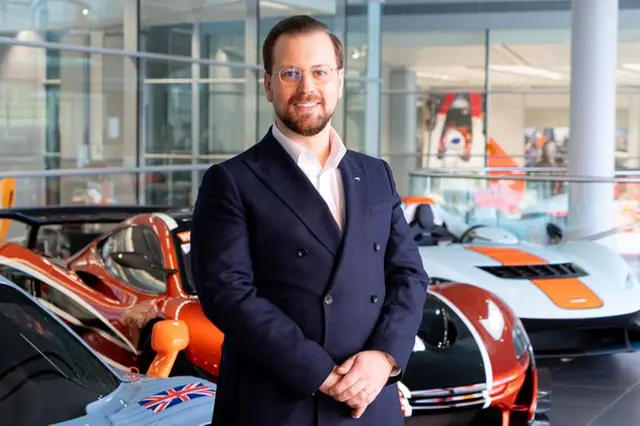Luxury supercar maker McLaren Automotive today announces the appointment of Matthew Boguradzki to the role of Regional Director for Europe, the Middle East, India and Africa.
With a wealth of international sales experience including Head of Sales – Americas at Rolls-Royce Motor Cars and a series of senior sales leadership roles at BMW, Matthew’s expertise and leadership will be invaluable as McLaren continues to drive demand for the brand and deliver the highest standards of customer service.
Matthew’s appointment follows Brett Soso’s decision to step down having spent six years leading McLaren’s business activities in EMEIA. Brett will leave the business at the end of the year providing a smooth leadership transition period.
Commenting on his new role, Matthew added: “It’s a pleasure to be joining McLaren Automotive during what promises to be an exciting period of growth and expansion for the brand. McLaren Automotive is one of the world’s most iconic luxury brands. I am excited to take on the role of managing and developing our operations in Europe, the Middle East, India and Africa, and I look forward to playing a key role in our continued success.”
About McLaren Automotive:
McLaren Automotive is a producer of ultra high-performance, lightweight supercars. Launched in 2010, the company is now the largest part of the McLaren Group.
Headquartered at the McLaren Technology Centre (MTC) in Woking, Surrey, England, McLaren Automotive is driven by the challenge of creating the world’s most exhilarating, engaging and benchmark setting vehicles. Leveraging over 60 years of history in authentic, racing performance, McLaren has delivered some of the most spectacular supercars ever made.
The company’s product portfolio of GTS, supercar, Motorsport and Ultimate models are retailed in over 40 markets around the world. Its cars are assembled by hand at the McLaren Production Centre (MPC), based on the same campus as MTC in Woking.
McLaren is a pioneer that continuously pushes the boundaries. In 1981, it introduced lightweight and strong carbon fibre chassis technology into Formula 1 with the McLaren MP4/1.
Then in 1993 it designed and built the legendary McLaren F1 road car. Built around a carbon fibre chassis, it established McLaren’s supercar DNA, realised for the 21st century in 2011 with the introduction of the McLaren 12C – McLaren Automotive’s first production car.
McLaren was the first to deliver a hybrid hypercar, the McLaren P1™, in 2013. Launching the Ultimate Series of vehicles, P1™ was followed by the McLaren Senna in 2018 and its track-only GTR derivative followed a year later. 2019 also saw the introduction of the Speedtail hybrid hyper-GT and at the end of the year the open-cockpit Elva roadster – the lightest McLaren road car ever – was announced.
McLaren’s LT models represent the ultimate expression of track performance in series production supercars. Limited in volume, they are distinguished by a name coming from the ‘Longtail’ version of the F1 GTR, which first raced in 1997. The LT designation was incorporated into McLaren Automotive nomenclature in 2015 with the arrival of the 675LT coupe and 675LT Spider. In 2018, the McLaren LT portfolio grew with the announcement of the 600LT, and in 2020 and 2021 respectively the 765LT coupe and 765LT Spider were introduced.
Also in 2021, the company unveiled its all-new high-performance hybrid supercar, the McLaren Artura. The Artura is the first McLaren to benefit from the McLaren Carbon Lightweight Architecture (MCLA). The MCLA is designed, developed and manufactured at the McLaren Composites Technology Centre in the Sheffield region of England using world-first processes and will spearhead the brand’s electrified future.
2022 saw McLaren announce the Solus GT, a single-seat, closed-cockpit track car which brought to life a futuristic concept that was originally created for virtual gaming.
In 2023, McLaren unveiled its lightest and most powerful series-production supercar, the 750S – a thorough development of the award-winning 720S supercar. McLaren also introduced the new GTS, replacing the McLaren GT.
The McLaren Artura Spider was revealed in early 2024 as the brand’s first high-performance hybrid convertible. Its introduction was part of a major model year uplift for the Artura nameplate, and meant McLaren’s series-production line-up of GTS, new Artura and 750S had been introduced within 12 months of each other.
A new chapter in the McLaren ‘1’ car story was announced in October 2024, with the reveal of the McLaren W1 supercar. A clear successor to the McLaren F1 and McLaren P1, the W1 is the manifestation of McLaren’s World Championship mindset, with epic power and performance and new heights of dynamic and aerodynamic excellence.
McLaren Automotive also chooses to partner with like-minded, world-leading companies and organisations who push the boundaries in their respective fields. These include Ashurst, Bowers & Wilkins, Dynisma, Gulf, Pirelli, Richard Mille and Tumi.
About McLaren Group:
The McLaren Group is a global leader in high-performance supercar production and elite motorsports.
Founded in 1963 by racer, engineer and entrepreneur Bruce McLaren, the Group is formed of McLaren Automotive, which hand-builds lightweight supercars and races them in global series, including the World Endurance Championship; and a majority stake in McLaren Racing which competes in the Formula 1 World Championship, INDYCAR series, Formula E, Extreme E and F1 Academy.
The Group is globally headquartered at the iconic McLaren Technology Centre in Woking, Surrey, England.
With a reputation for innovation and technological excellence, McLaren is one of the UK’s largest independent companies.

